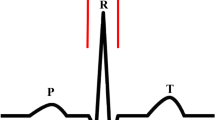Abstract
In this work, an algorithm based on digital signal processing and machine learning is developed for QRS complexes detection in ECG signals. The algorithm for locating the complexes uses a gradient signal and the KNN classification method. In the first step, an efficient process for denoising signals using Stationary Wavelet Transform (SWT), Discrete Wavelet Transform (DWT), and a combination of filtering thresholds is developed. In the second stage, the phase of fiducial points detection is carry out, the gradient of the signal is computed for being used as a feature for the detection of the R-peak. Therefore, a KNN classification method is used in order to separate R-peaks and non R-peaks. The algorithm computes a set of thresholds to recalculate the R-peaks positions that has been omitted or falsely detected due to the ECG wave forms. Finally, the each R peak permits locate Q and S peaks. The results indicate that the algorithm correctly detects \(99.7\%\) of the QRS complexes for the MIT-BIH Arrhythmia database and the \(99.8\% \) using the QT Database. The average processing-time that the algorithm takes to process a signal from the denoising stage to fiducial points detection is 4.95 s.
Access this chapter
Tax calculation will be finalised at checkout
Purchases are for personal use only
Similar content being viewed by others
References
Blanco-Velasco, M., Cruz-Roldán, F., Godino-Llorente, J.I., Barner, K.E.: Nonlinear trend estimation of the ventricular repolarization segment for T-wave alternans detection. IEEE Trans. Biomed. Eng. 57(10), 2402–2412 (2010)
Nemati, S., Abdala, O., Monasterio, V., Yim-Yeh, S., Malhotra, A., Clifford, G.D.: A nonparametric surrogate-based test of significance for T-wave alternans detection. IEEE Trans. Biomed. Eng. 58(5), 1356–1364 (2011)
Sörnmo, L., Laguna, P.: Bioelectrical Signal Processing in Cardiac and Neurological Applications, vol. 8. Academic Press, Cambridge (2005)
Iravanian, S., Kanu, U.B., Christini, D.J.: A class of monte-carlo-based statistical algorithms for efficient detection of repolarization alternans. IEEE Trans. Biomed. Eng. 59(7), 1882–1891 (2012)
Irshad, A., Bakhshi, A.D., Bashir, S.: Department of electrical engineering, College of electrical and mechanical engineering, national University of science and technology, Islamabad, Pakistan. Department of electrical engineering, University of engineering and technology, Lahore, Pakista, pp. 222–227 (2015)
Madeiro, J.P., Cortez, P.C., Marques, J.A., Seisdedos, C.R., Sobrinho, C.R.: An innovative approach of QRS segmentation based on first-derivative, hilbert and wavelet transforms. Med. Eng. Phys. 34(9), 1236–1246 (2012)
Pham, Q., Quan, K.J., Rosenbaum, D.S.: T-Wave alternans: marker, mechanism, and methodology for predicting sudden cardiac death. J. Electrocardiol. 36(Suppl.), 75–81 (2003)
Sanamdikar, S.T.: Extraction of different features of ECG signal for detection of cardiac arrhythmias by using wavelet transformation Db 6. In: 2017 International Conference on Energy, Communication, Data Analytics and Soft Computing (ICECDS), pp. 2407–2412 (2017)
Sharma, L.D., Sunkaria, R.K.: A robust QRS detection using novel pre-processing techniques and kurtosis based enhanced efficiency. Measurement 87, 194–204 (2016)
Nannaparaju, V., Narasimman, S.: Detection of T-wave alternans in ECGs by wavelet analysis. Procedia Mat. Sci. 10(2014), 307–313 (2015)
Li, Z., Ni, J., Gu, X.: A denoising framework for ECG signal preprocessing. In: Proceedings - 6th International Conference on Internet Computing for Science and Engineering, ICICSE 2012, pp. 176–179 (2012)
Noohi, M., Sadr, A.: T wave detection by correlation method in the ECG signal. In: 2010 The 2nd International Conference on Computer and Automation Engineering (ICCAE), vol. 5, pp. 550–552 (2010)
Martinez, J.P., Almeida, R., Olmos, S., Rocha, A.P., Laguna, P.: A wavelet-based ECG delineator: evaluation on standard databases. IEEE Trans. Biomed. Eng. 51(4), 570–581 (2004)
Strasser, F., Muma, M., Zoubir, A.M.: Motion artifact removal in ECG signals using multi-resolution thresholding. In: European Signal Processing Conference (Eusipco), pp. 899–903 (2012)
Moody, G.B., Mark, R.G.: The impact of the MIT-BIH arrhythmia database. IEEE Eng. Med. Biol. Mag. 20(3), 45–50 (2001)
Saini, I., Singh, D., Khosla, A.: QRS detection using k-nearest neighbor algorithm (KNN) and evaluation on standard ECG databases. J. Adv. Res. 4(4), 331–344 (2013)
Laguna, P., Mark, R.G., Goldberg, A., Moody, G.B.: A database for evaluation of algorithms for measurement of QT and other waveform intervals in the ECG. In: Computers in cardiology 1997, pp. 673–676. IEEE (1997)
Goldberger, A.L., et al.: Physiobank, physiotoolkit, and physionet: components of a new research resource for complex physiologic signals. Circulation 101(23), e215–e220 (2000)
Pan, J., Tompkins, W.J.: Pan tomkins 1985 - QRS detection.pdf. IEEE Trans. Biomed. Eng. 32(3), 230–236 (1985)
Yakut, Ö., Bolat, E.D.: An improved QRS complex detection method having low computational load. Biomed. Sig. Process. Control 42, 230–241 (2018)
Author information
Authors and Affiliations
Corresponding author
Editor information
Editors and Affiliations
Rights and permissions
Copyright information
© 2021 Springer Nature Switzerland AG
About this paper
Cite this paper
Betancourt, N., Flores-Calero, M., Almeida, C. (2021). An Algorithm for Automatic QRS Delineation Based on ECG-gradient Signal. In: Guarda, T., Portela, F., Santos, M.F. (eds) Advanced Research in Technologies, Information, Innovation and Sustainability. ARTIIS 2021. Communications in Computer and Information Science, vol 1485. Springer, Cham. https://doi.org/10.1007/978-3-030-90241-4_10
Download citation
DOI: https://doi.org/10.1007/978-3-030-90241-4_10
Published:
Publisher Name: Springer, Cham
Print ISBN: 978-3-030-90240-7
Online ISBN: 978-3-030-90241-4
eBook Packages: Computer ScienceComputer Science (R0)




